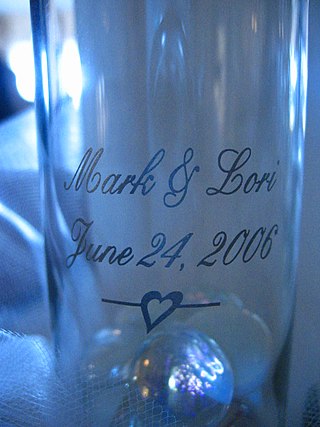
Waiting staff (BrE), waiters / waitresses, or servers (AmE) are those who work at a restaurant, a diner, or a bar and sometimes in private homes, attending to customers by supplying them with food and drink as requested. Waiting staff follow rules and guidelines determined by the manager. Waiting staff carry out many different tasks, such as taking orders, food-running, polishing dishes and silverware, helping bus tables, entertaining patrons, restocking working stations with needed supplies, and handing out the bill.

Service à la française is the practice of serving various dishes of a meal at the same time, with the diners helping themselves from the serving dishes. That contrasts to service à la russe in which dishes are brought to the table sequentially and served individually, portioned by servants.

A buffet can be either a sideboard or a system of serving meals in which food is placed in a public area where the diners serve themselves. A form of service à la française, buffets are offered at various places including hotels, restaurants, and many social events. Buffet restaurants normally offer all-you-can-eat food for a set price, but some measure prices by weight or by number of dishes. Buffets usually have some or mostly hot dishes, so the term cold buffet has been developed to describe formats lacking hot food. Hot or cold buffets usually involve dishware and utensils, but a finger buffet is an array of foods that are designed to be small and easily consumed only by hand, such as cupcakes, slices of pizza, foods on cocktail sticks, etc.

Tableware items are the dishware and utensils used for setting a table, serving food, and dining. The term includes cutlery, glassware, serving dishes, serving utensils, and other items used for practical as well as decorative purposes. The quality, nature, variety and number of objects varies according to culture, religion, number of diners, cuisine and occasion. For example, Middle Eastern, Indian or Polynesian food culture and cuisine sometimes limits tableware to serving dishes, using bread or leaves as individual plates, and not infrequently without use of cutlery. Special occasions are usually reflected in higher quality tableware.

A toast is a ritual during which a drink is taken as an expression of honor or goodwill. The term may be applied to the person or thing so honored, the drink taken, or the verbal expression accompanying the drink. Thus, a person could be "the toast of the evening", for whom someone "proposes a toast" to congratulate and for whom a third person "toasts" in agreement. The ritual forms the basis of the literary and performance genre, of which Mark Twain's "To the Babies" is a well-known example.
Silver service is a method of food service at the table, with the waiter transferring food from a serving dish to the guest's plate, always from the left. It is performed by a waiter using service forks and spoons from the diner's left. In France, it appears to be now known as service à l'anglaise, although historically that meant something else, with the hostess serving out the soup at one end of the table, and later the host carving a joint of meat at the other end, and diners serving themselves with other dishes present.

A Jewish wedding is a wedding ceremony that follows Jewish laws and traditions. While wedding ceremonies vary, common features of a Jewish wedding include a ketubah which is signed by two witnesses, a chuppah or huppah, a ring owned by the groom that is given to the bride under the canopy, and the breaking of a glass.

Kūčios or Kūtės is the traditional Christmas Eve dinner in Lithuania, held on December 24. The meal is a family occasion which includes many traditions of both pagan and Christian origin. Some traditions are no longer widespread and usually Lithuanians just enjoy dinner with relatives and friends while the main events and festivities are left for Christmas Day.

It's in the Bag! is a 1945 comedy film featuring Fred Allen in his only starring film role. The film was released by United Artists at a time when Allen was at the peak of his fame as one of the most popular radio comedians. The film has been preserved by UCLA Film & Television Archive. The film is loosely based on the comic novel The Twelve Chairs (1928) of Ilf and Petrov, later filmed by Mel Brooks as The Twelve Chairs (1970). The team of screenwriters included Jay Dratler, Alma Reville, and Morrie Ryskind. Allen's encounter with Jack Benny in the film is notable as at this time they were involved in a famous 'feud', which ran for over a decade.

Nightclubs in Greece are divided into two main categories: those with live Greek music, and discotheques or bars playing recorded Greek, American or European music.
Polterabend is a German and to a lesser extent Polish, Austrian and Swiss wedding custom in which, on the night before the wedding, the guests break porcelain to bring luck to the couple's marriage. The belief in the effectiveness of this custom is expressed by the old adage: "Shards bring luck". The expression is derived from a time when the word "shard" referred to the unbroken clay pots of pottery makers, and not just the broken pieces. It was said that a full jar was a lucky thing to have, therefore the expression "shards bring luck".

An engagement party, also known as a betrothal party or fort, is a party held to celebrate a couple's recent engagement and to help future wedding guests to get to know one another. Traditionally, the bride's parents host the engagement party, but many modern couples host their own celebration.

A loyal toast is a salute given to the sovereign monarch or head of state of the country in which a formal gathering is being given, or by expatriates of that country, whether or not the particular head of state is present. It is usually a matter of protocol at state and military occasions, and a display of patriotic sentiment at civilian events. The toast is usually initiated and recited by the host before being repeated by the assembled guests in unison; the composition varying between regions and types of gathering. There is sometimes a tradition of smashing a glass used for a loyal toast, so that no lesser toast can be made with it.
In the United States and Canada, weddings follow traditions often based on religion, culture, and social norms. Most wedding traditions in the United States and Canada were assimilated from other, generally European, countries. Marriages in the U.S. and Canada are typically arranged by the participants and ceremonies may either be religious or civil. There is a tradition that the prospective bridegroom ask his future father-in-law for his blessing.

Customs and etiquette in Chinese dining are the traditional behaviors observed while eating in Greater China. Traditional Han customs have spread throughout East Asia to varying degrees, with some regions sharing a few aspects of formal dining, which has ranged from guest seating to paying the bill.
Breaking glass is the action of damaging or destroying a glass object. It may also refer to:

Traditional marriage customs in the Philippines and Filipino wedding practices pertain to the characteristics of marriage and wedding traditions established and adhered by them Filipino men and women in the Philippines after a period of adoption courtship and engagement. These traditions extend to other countries around the world where Filipino communities exist. Kasalan is the Filipino word for "wedding", while its root word – kasal – means "marriage". The present-day character of marriages and weddings in the Philippines were primarily influenced by the permutation of Christian, both Catholic and Protestant, Hindu, Islam, Chinese, Spanish, and American models.

Las arras, or las arras matrimoniales are wedding paraphernalia used in Christian wedding ceremonies in Spain, Latin American countries, and the Philippines. The tradition is also followed, with varying names and customs, in other countries and communities bearing degrees of Hispanic influence. Traditionally, in Spain and Latin America, it is made up of thirteen gold coins presented in an ornate box or chest; in the Philippines, it is in an ornate basket or pouch. After being blessed by a priest, they are given or presented by the groom to the bride.

Japanese dining etiquette is a set of traditional perceptions governing specific expectations which outlines general standards of how one should behave and respond in various dining situations.














